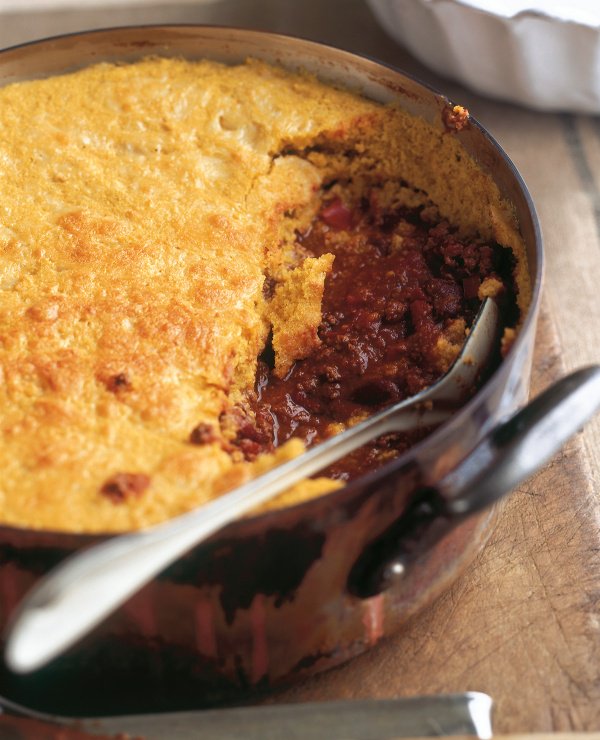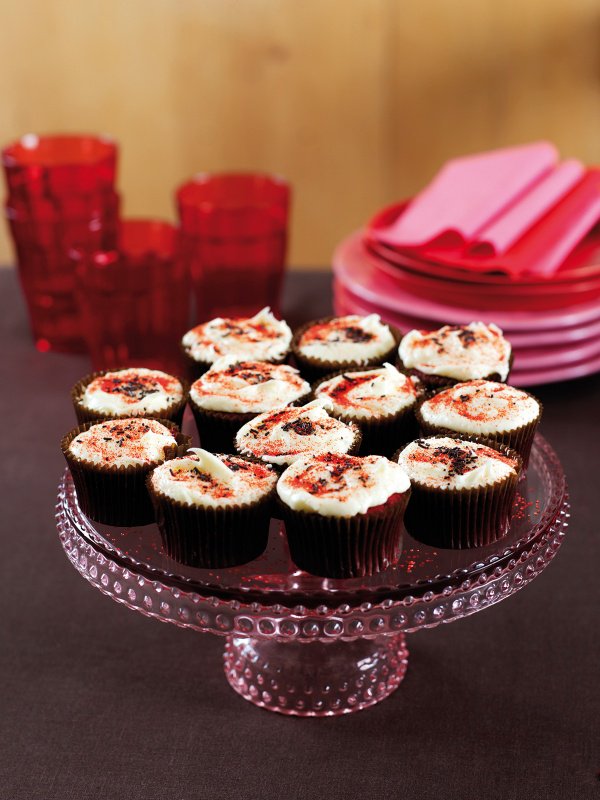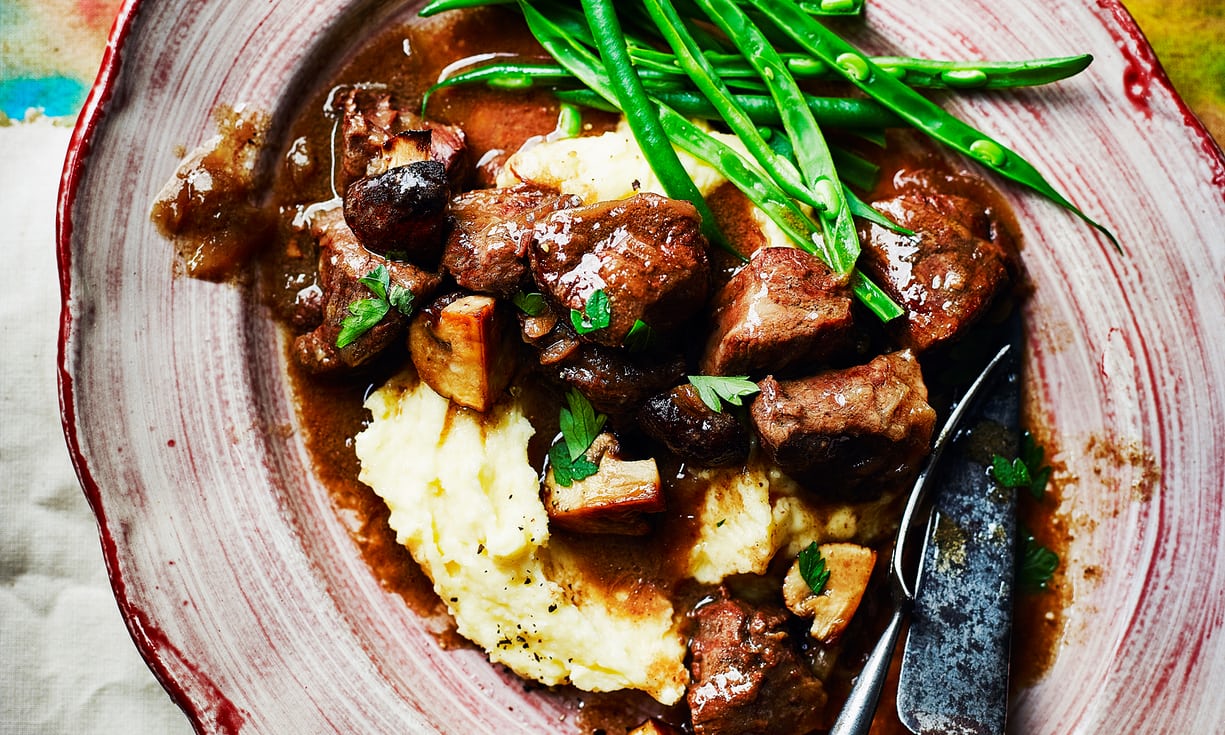Cornbread-Topped Chili Warms Winter Nights (and Days)
 Friday, January 5, 2018 at 3:56PM
Friday, January 5, 2018 at 3:56PM There are few more welcome sights than a big vat of chilli. The cornbread topping is a glorious golden touch, that everyone can crumble into the spiced meat as they eat, for ballast and crunchy contrast. It makes your life easier and the chilli better if you make the meat up in advance, adding the topping and baking the lot just before you serve.
INGREDIENTS
Serves: up to 20
FOR THE CHILLI CON CARNE
- 4 onions
- 4 x 14 ounces cans of diced tomatoes
- 8 tablespoons tomato ketchup
- 8 tablespoons tomato puree
- 1 cup water
- 2 tablespoons unsweetened cocoa
- 2 x 15 ounces cans of kidney beans (drained)
- 2 cloves garlic
- 4 tablespoons olive oil
- 2 teaspoons dried chiles (or to taste)
- 2 teaspoons ground coriander
- 2 teaspoons ground cumin
- 5 cardamom pods (bruised)
- 2 red bell peppers
- 3¼ pounds ground beef
FOR THE CORNBREAD
- 1½ teaspoons salt
- 4 cups cornmeal
- 4 tablespoons all-purpose flour
- 6 teaspoons baking powder
- 2 teaspoons ground cinnamon
- 3 cups buttermilk
- 4 large eggs
- 2 teaspoons honey
- 4 tablespoons vegetable oil
- 2 cups coarsely grated cheddar cheese
TO SERVE
- 4 ripe avocados
- 4 scallions
- juice of 2 limes
- 4 tablespoons chopped cilantro
- 2 cups sour cream
- paprika to dust over
- 3¾ cups grated cheddar cheese
METHOD
- Peel and finely chop the onions; you might want to use the processor here, and if so, add the peeled garlic or mince it by hand. Heat the oil in a very large pan - it has to take everything later - and fry the onion and garlic until they begin to soften. Add the chilli, coriander, cumin and crushed cardamom pods and stir well.
- Deseed and finely dice the red bell peppers, and tip into the spicy onion. Break up the ground beef into the pan and, using a fork, keep turning it to separate it as the meat browns. It's hard to brown quite so much meat, so just do the best you can.
- Add the diced tomatoes, kidney beans, ketchup, puree and water, stirring to make a rich red sauce. When the chilli starts to boil, sprinkle over the cocoa and stir it in. Simmer partially covered for 1½ hours. At this point you can cool and freeze the chilli, or just keep it in the fridge - or a cool place - overnight.
- Preheat the oven to gas mark 7/425ºF. Tip the chilli into a large, wide dish or keep in the pan that is ovenproof.
- Combine the salt, cornmeal, flour, baking powder and cinnamon in a bowl.
- Whisk together the buttermilk, eggs, honey and oil in a jug, and then stir into the dry ingredients, mixing to make a vivid yellow batter.
- Pour the cornmeal topping over the chilli con carne, or blob it over to cover the top as evenly as possible. Don't worry if some of the chilli seeps through as this won't matter one tiny bit.
- Sprinkle the cheese over the top of the cornbread and then bake in the oven for 30 minutes or until the cornbread topping is risen and golden and the chilli underneath is bubbling. How long this precisely takes depends on how cold or hot the chilli was when it went into the oven. Since it's such a huge vat, you may find it simpler to reheat it on the stove in its pan, before it gets its topping, to start with.
- Let the chilli stand for about 5 minutes once out of the oven before cutting the top into squares or slices to serve with a helping of chilli underneath.
- And alongside this chilli, as with the vegetarian chilli overleaf, you should dollop out an un-chillied guacamole, some cool sour cream and a mounded pile of strong grated Cheddar. So, mash the ripe avocados with the finely chopped scallions and add the lime juice and some salt to taste. Stir in most of the chopped coriander and turn into two bowls, sprinkling each with the remaining coriander.
- Divide the sour cream into another two bowls, and dust with a little paprika and, into yet another pair of bowls, grate the Cheddar so that people can take clumps and add the tangy cheese to their plates of guacamole and sour-cream splodged chilli.
This recipe is featured in Nigella Lawson's "Feast," Available at Amazon and other bookstores. 
 Editor | Comments Off |
Editor | Comments Off | 









